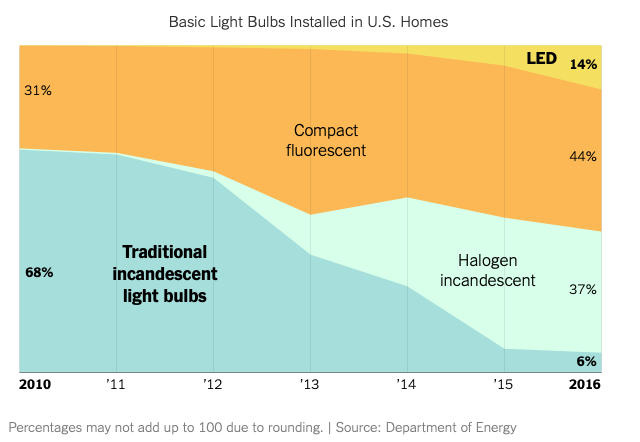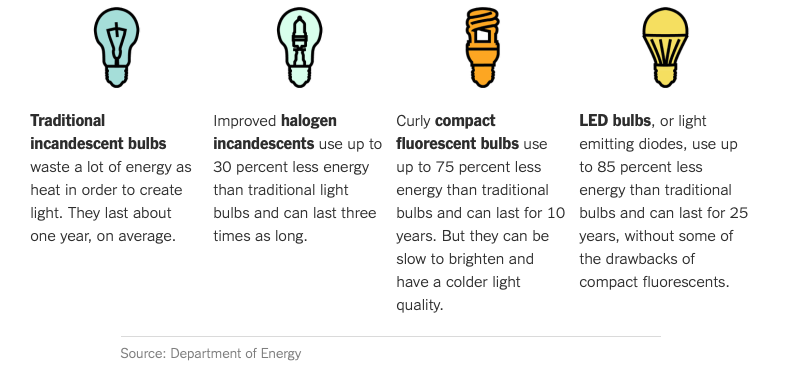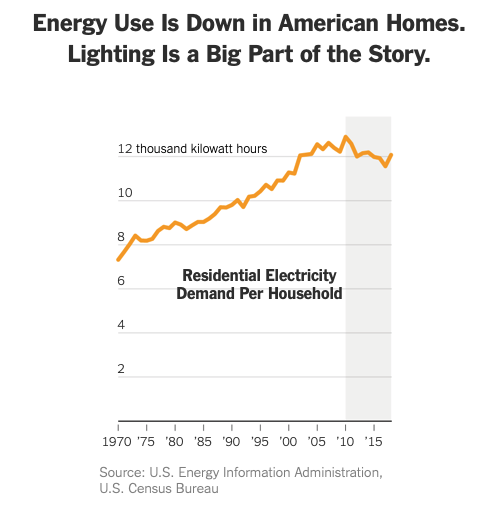- 43 reads

Source - NADJA POPOVICH, NEW YORK TIMES, MARCH 8, 2019

Solar panels and wind turbines get a lot of attention, but a more inconspicuous instrument is helping to reshape America’s energy economy right now: The humble light bulb.
Over the past decade, traditional incandescent bulbs, those distinctive glass orbs with glowing wire centers, have been rapidly replaced by more energy-efficient lighting. The shift has driven down electricity demand in American homes, saving consumers money and cutting greenhouse gas emissions.
The energy savings are expected to grow as highly efficient and increasingly inexpensive LED bulbs continue to replace older lights. But energy efficiency advocates worry that the Trump administration could slow the pace of this lighting revolution.
Last month, the Department of Energy said it would withdraw an Obama-era regulation that nearly doubled the number of light bulbs subject to energy-efficiency requirements. (The chart above shows changes for basic, pear-shaped bulbs that are regulated by current rules. Other bulb styles, including globe, candelabra and reflector bulbs, as well as outdoor lighting, are not included.)
Industry groups are also pushing back on new lighting efficiency requirements slated to go into effect next year.
After climbing for decades, electricity use by American households has declined over the past eight years.
“That’s a staggering change,” said Lucas Davis, an energy economist at the Haas School of Business, part of the University of California, Berkeley.
The economic recession in the late 2000s contributed to an initial dip in electricity demand, but as the economy improved, lighting and other energy-efficiency improvements continued to drive down household electricity use.
Congress established the first national light bulb efficiency standards in 2007, which were signed into law by President George W. Bush. Starting in 2012, the law required new light bulbs to use 28 percent less power than existing incandescent lights — essentially ending the sale of the older, inefficient bulbs.
A new generation of halogen bulbs initially replaced traditional incandescents, but, more recently, sales of highly efficient LEDs have grown as their prices have fallen.
The switch to more efficient lighting has been relatively rapid, Dr. Davis said, because of the short lifespan of traditional light bulbs. While consumers may replace an old refrigerator or dishwasher with an energy-saving model once a decade, incandescent bulbs last only about a year before they need replacing.
And that replacement yields huge relative savings.
“When you take out incandescent light bulbs and replace them with LEDs, the amount of electricity you consume goes down more than 80 percent,” Dr. Davis said. “There’s nothing else like that.”

The Future of Lighting Efficiency
A second phase of the 2007 lighting efficiency rules is scheduled to go into effect next year, prohibiting the sale of lightbulbs that put out less than 45 lumens per watt. Currently, only compact fluorescent and LED bulbs can meet that requirement. That means all basic incandescent bulbs, including the recent generation of halogens, would be eliminated from store shelves on Jan. 1.
Industry groups have contested that standard, along with an Obama-era ruling that expanded which light bulbs it would apply to. The Department of Energy said last month that it had erred when it determined in 2017 that certain decorative and non-basic bulb styles would be subject to the 2020 standards.
Clark Silcox, a lawyer for the National Electrical Manufacturers Association, a trade group that represents major lighting manufacturers like General Electric and Signify (formerly Philips Lighting), said that consumers were already switching to highly efficient LED bulbs on their own, pointing to industry data that shows LEDs outsold all other types of bulbs for the first time in 2017.
“The question now is: Does the Department of Energy accelerate that by putting on a ban,” Mr. Silcox said, even if it would “disrupt retail terribly.”
But Noah Horowitz, a senior scientist at the Natural Resources Defense Council, said “there’s no reason to move backward,” adding that the lighting industry has had years to prepare for the next phase of efficiency rules.
“The LEDs are already on the shelf,” he said. “They work great, they last longer and they use one-sixth of the power.”
About ASG Energy LLC
ASG Energy LLC is a comprehensive LED energy solutions provider with a successful track record of managing energy reduction initiatives and installations for several Fortune 500 companies throughout the U.S. ASG Energy’s energy solutions include LED lighting Air Conditioning Optimization, Solar and Energy Storage. ASG utilizes professional project managers and engineers for all our commercial and industrial customers, medical centers and schools to assist our clients in realizing rapid cost savings, as well as, reducing greenhouse gas emissions and improving facility lighting and safety. For additional information please visit www.asgenergyllc.comor email at info@asgenergyllc.com.
About Revolution Energy Group
Revolution Energy Group was established to provide next generation commercial energy efficiency solutions. Revolution supports public and private sector facility owners and managers who seek high ROI “Energy Intelligence” to reduce operating costs and meet sustainability goals. For more information please visit www.revolutionenergygroup.com. See this link for the optimization beyond HVAC Optimization


